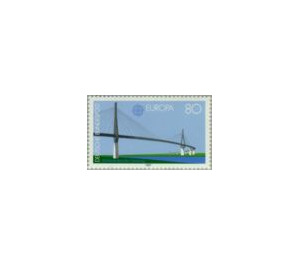Europe - Germany / Federal Republic of Germany 1987 - 80 Pfennig
Theme: Architecture
| Country | Germany / Federal Republic of Germany |
| Issue Date | 1987 |
| Face Value | 80.00 |
| Color | blue |
| Perforation | K 14 |
| Printing Type | Multicolor offset printing |
| Stamp Type | Postage stamp |
| Item Type | Stamp |
| Chronological Issue Number | 1195 |
| Chronological Chapter | GER-BRD |
| SID | 115325 |
| In 56 Wishlists | |
In the context of the XI. The European Conference of Postal and Telecommunications Administrations (CEPT) has selected the common theme "Modern Art" (with emphasis on architecture) for the 1987 European brands. Under this general theme, the Deutsche Bundespost honors two outstanding architectural achievements with the »German Pavilion Barcelona« and the »Köhlbrand Bridge Hamburg«. After the Second World War, bridge construction in particular in the Federal Republic of Germany has experienced a great upswing. Due to the production of new and improved building materials, German civil engineers were able to develop new steel and prestressed concrete bridge systems, which are now used all over the world. Among the most significant innovations in large bridge construction are the so-called cable-stayed bridges. With this bridge type, with which spans of up to 700 m can be achieved, the roadway carrier is not supported from below by pillars, but held by diagonally suspended over pylons ropes. Such a cable-stayed bridge is also completed in 1974 Köhlbrandbrücke Hamburg, whose 520 m long steel carriage with a 325 m wide central opening of 88 fan-shaped steel cables is held at a height of 52 m a four-lane road on the shipping lane Köhlbrand and the various areas of the Hamburger Hafens to the federal highway A 7 connects. Like almost no other bridge system, a cable-stayed bridge realizes today's notions of the elegance, power and functionality of modern engineering structures. These requirements are met in particular by the Köhlbrandbrücke Hamburg, whose 130-meter-high pylons are reminiscent of two oversized tuning forks and whose track girders, like a seemingly feather-light curve, meet the ancient human desire to bridge obstacles. (Text: Federal Ministry of Transport, Bonn, Department Road Construction, Department Bridge and Civil Engineering)



